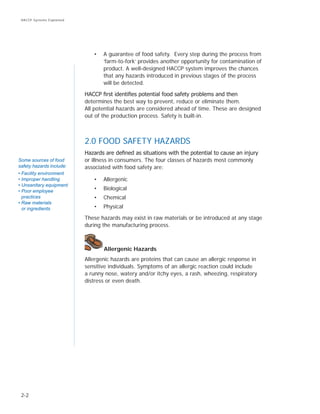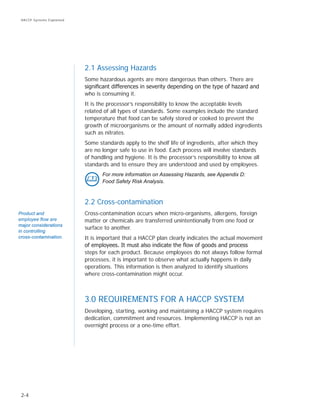This document provides an overview of Hazard Analysis Critical Control Point (HACCP) systems and their basic requirements. It explains that HACCP focuses on preventing food safety hazards through identification and control of critical control points. An effective HACCP system requires management commitment, selecting a HACCP team, training, developing prerequisite programs, and implementing HACCP plans to control hazards directly related to food products and processes. Prerequisite programs establish standard operating procedures to control general facility hazards, while HACCP plans specifically identify critical control points and monitoring procedures.











![2-11
HACCP Systems Explained
5.0 SOURCES OF INFORMATION
1. Motarjemi, Y. et al. (1999) HACCP Principles and Practice – Teacher’s
Handbook [online], World Health Organization and Industry Council for
Development. Available from: www.icd-online.org/an/html/download.
html.
2. Gardner, S. (1993) Consumers and Food Safety: A Food Industry
Perspective [online], Food and Agriculture Organization of the United
Nations. Available from: http://www.fao.org/DOCREP/V2890T/v2890t05.
htm.
3. Guelph Food Technology Centre (2002) Food Safety and Food Security
Program Review [online], Available from: www.gftc.ca/training/pdf/food-
security-checklist.pdf.
4. BC Centre for Disease Control (2004) Ensuring Food Safety – Writing
Your Own Food Safety Plan – The HACCP Way – A Guide for Food
Service Operators [online], Available from: www.bccdc.org/downloads/
pdf/fps/reports/EnsuringFoodSafety-HACCPWay.pdf?PHPSESSID=ae4ed3
2a0fac956216dcbb04e304d837.
5. J.J. Keller and Associates Inc. (2002) Employee’s Guide to Food Safety.
2nd ed.
6. State of Victoria Department of Human Services (2004) Food Safety
Program Template for Retail and Food Service Businesses. 1.1 ed.
7. Canadian Produce Marketing Association (2003) Repacking and
Wholesale Food Safety Standard – For Fresh Fruits and Vegetables.
8. NSW Food Authority (2005) Industry Guide to Developing a Food Safety
Program (Hospitals and Aged Care).
9. Jenner, T., Kinnear, H. and Menyhar, C. (2005) The HACCP Advantage
Guidebook, Ontario Ministry of Agriculture and Food.
10. Bernard, D. and Stevenson, K. (1993) Food Processing [online],
HACCP QA. Available from: http://www.allbusiness.com/periodicals/
article/403932-1.html.](https://image.slidesharecdn.com/haccptraining-190430055356/85/Haccp-training-12-320.jpg)